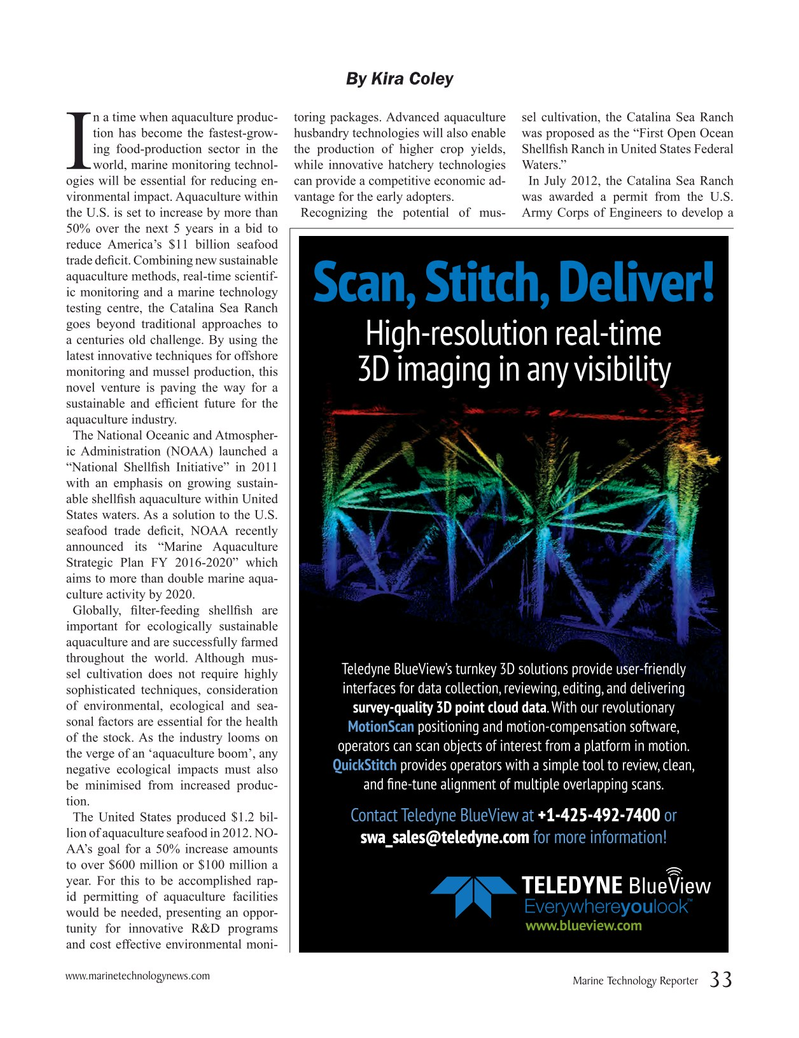
Page 33: of Marine Technology Magazine (November 2015)
Read this page in Pdf, Flash or Html5 edition of November 2015 Marine Technology Magazine
By Kira Coley n a time when aquaculture produc- toring packages. Advanced aquaculture sel cultivation, the Catalina Sea Ranch tion has become the fastest-grow- husbandry technologies will also enable was proposed as the “First Open Ocean ing food-production sector in the the production of higher crop yields, Shell? sh Ranch in United States Federal
Iworld, marine monitoring technol- while innovative hatchery technologies Waters.” ogies will be essential for reducing en- can provide a competitive economic ad- In July 2012, the Catalina Sea Ranch vironmental impact. Aquaculture within vantage for the early adopters. was awarded a permit from the U.S. the U.S. is set to increase by more than Recognizing the potential of mus- Army Corps of Engineers to develop a 50% over the next 5 years in a bid to reduce America’s $11 billion seafood trade de? cit. Combining new sustainable aquaculture methods, real-time scientif- ic monitoring and a marine technology
Scan, Stitch, Deliver!
testing centre, the Catalina Sea Ranch goes beyond traditional approaches to a centuries old challenge. By using the
High-resolution real-time latest innovative techniques for offshore monitoring and mussel production, this 3D imaging in any visibility novel venture is paving the way for a sustainable and ef? cient future for the aquaculture industry.
The National Oceanic and Atmospher- ic Administration (NOAA) launched a “National Shell? sh Initiative” in 2011 with an emphasis on growing sustain- able shell? sh aquaculture within United
States waters. As a solution to the U.S. seafood trade de? cit, NOAA recently announced its “Marine Aquaculture
Strategic Plan FY 2016-2020” which aims to more than double marine aqua- culture activity by 2020.
Globally, ? lter-feeding shell? sh are important for ecologically sustainable aquaculture and are successfully farmed throughout the world. Although mus-
Teledyne BlueView’s turnkey 3D solutions provide user-friendly sel cultivation does not require highly interfaces for data collection, reviewing, editing, and delivering sophisticated techniques, consideration of environmental, ecological and sea- survey-quality 3D point cloud data. With our revolutionary sonal factors are essential for the health
MotionScan positioning and motion-compensation software, of the stock. As the industry looms on operators can scan objects of interest from a platform in motion. the verge of an ‘aquaculture boom’, any
QuickStitch provides operators with a simple tool to review, clean, negative ecological impacts must also and ?ne-tune alignment of multiple overlapping scans.
be minimised from increased produc- tion.
The United States produced $1.2 bil-
Contact Teledyne BlueView at +1-425-492-7400 or lion of aquaculture seafood in 2012. NO- [email protected] for more information!
AA’s goal for a 50% increase amounts to over $600 million or $100 million a year. For this to be accomplished rap- id permitting of aquaculture facilities would be needed, presenting an oppor- www.blueview.com tunity for innovative R&D programs and cost effective environmental moni- www.marinetechnologynews.com
Marine Technology Reporter 33
MTR #9 (18-33).indd 33 12/9/2015 9:05:59 AM

 32
32

 34
34
